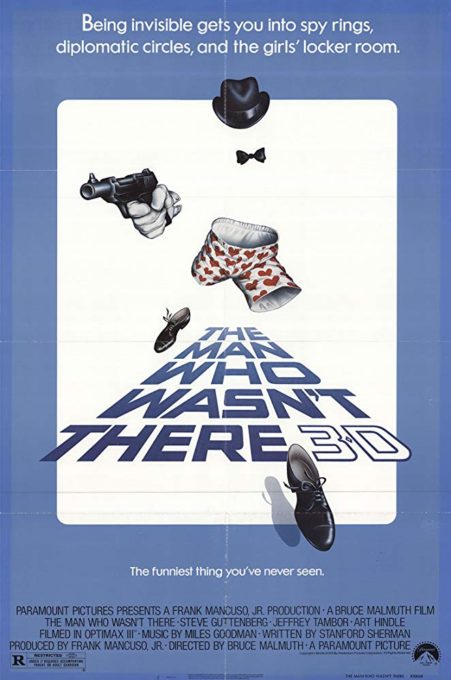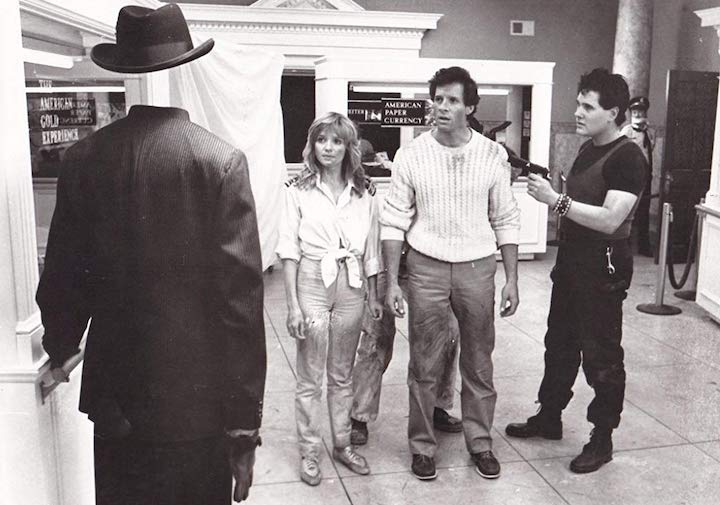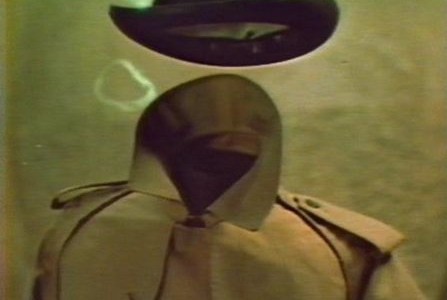With the US release of Blumhouse’s THE INVISIBLE MAN this week, we’re going to take a look at films with characters that are hard to see. For this is…

Has anyone written a book on the glut of truly awful 3-D movies that flooded theaters in 1983? Just off the top of my head, I can think of such stinkers as JAWS 3-D, AMITYVILLE 3-D, SPACEHUNTER: ADVENTURES IN THE FORBIDDEN ZONE, METALSTORM: THE DESTRUCTION OF JARED-SYN, and FRIDAY THE 13TH PART III. That the film starring Jason Voorhees is easily the best one from that list is fairly damning when we’re talking about movies where characters awkwardly shove long instruments at the camera. But you know what is even more damning? That I can safely say that all of those wretched excuses for cinema are still better than THE MAN WHO WASN’T THERE.
Sam Cooper (Steve Guttenberg) is a low level State Department diplomat who—through a series of zany, hilarious mix ups that include cold-blooded murder—finds himself in possession of several vials of a liquid that turns him invisible for a period of time. In pursuit of the vials are a group of henchmen that appear to have been magically transported in from four different movie genres (street crime, gangster flick, western, and Andy Sidaris tropical action) working for another invisible person who dresses in a raincoat and fedora—making their invisibility mostly a moot point (but I’ll get to the myriad questionable choices in this flick in a couple of paragraphs).

Also after the formula are Boris (Jeffrey Tambor), a Russian diplomat/spy, and Ted (Art Hindle), a Naval Intelligence Officer—who just happens to be Sam’s best friend. And, for good measure, Sam ends up on the run with Cindy (Lisa Langlois), who happens to be the maid of honor for his fiancée Amanda (Morgan Hart), whom he had to run out on when…you know, he turned invisible and people started shooting at him.
One has so many questions when it comes to the events that happen in THE MAN WHO WASN’T THERE. First, how do Sam and Cindy wind up in the world’s fastest romance when just a day before he seemed perfectly happy to be marrying Amanda and she seemed supportive of her best friend? Neither of them have any qualms about jumping into bed together despite the potential pain it would cause this woman who they both supposedly care about. Why is it eventually revealed that Cindy’s uncle created the invisibility potion, but we never see or hear of this character before or after this revelation? What is the point of such a coincidence?
Why do Sam and Cindy drive a car straight into an alligator pit at the local zoo instead of, you know, braking? Does being invisible impair your ability to drive? How did a random old man know to open a hidden container and steal a vial of the invisibility formula? How did he use it? Why is this subplot abruptly dropped? What does the mystery invisible villain plan to do with the formula? Why do they keep killing their own henchmen by throwing them off buildings? Why does not one character in this movie display recognizable human behavior in even the tiniest of ways?!
If you have not yet guessed, THE MAN WHO WASN’T THERE is not just dumb; it’s staggeringly dumb. But its real sin is that it isn’t even dumb in a fun or “so bad it’s good” way. It’s dumb in a “this movie is so dumb that I fear I’ve actually killed several brain cells by watching it” kind of way. It’s dumb in a way that pissed me off for wasting time on it. It’s dumb in a way that made me angry with myself that I raised my hand and volunteered to actually watch the damn thing and then write about it.
I remember trying to watch THE MAN WHO WASN’T THERE several times circa 1985 when I was a not especially picky movie watcher. The damn thing was in heavy rotation on cable and Guttenberg was a major comedy star thanks to POLICE ACADEMY. That’s all I needed at that point in my life to stare at the TV for a couple of hours in those days. But even then, when my tolerance for crap was far more forgiving, I could not make it more than fifteen or twenty minutes into the flick. I distinctly remember it boring me to no end. Current me should have trusted the instincts of eleven-year-old me.

There are so many problems when it comes to this film that I hesitate to even try to delve into them all. I was prepared to forgive some dated optical effects to handle the movement of objects held by the invisible folks, but what I was not prepared for were the very visible strings causing things to appear to be floating (I watched the movie in a poorly preserved standard definition transfer, which makes me wonder just how hilariously obvious these tricks would be in an HD transfer).
An easy trick to help sell the idea that invisible characters are “on camera” would have been to record their dialogue on set with the visible actors. Here, the filmmakers continue doing things on the cheap by recording all their dialogue later (by the way, disembodied Guttenberg sounds distractingly like David Schwimmer) and so clumsily inserting the lines that it’s obvious that the actors aren’t actually talking to each other.

Much, much worse than sub-par effects is the screenplay by Stanford Sherman. Whether Sherman’s script was as insipid as the final on-screen product or director Bruce Malmuth was tearing pages out of it while shooting is unclear. Either way, THE MAN WHO WASN’T THERE relies on thudding obvious gags like Sam and Cindy becoming visible at awkward moments when they’re both naked, Sam leering at high school girls in a locker room shower (a locker room that was somehow accessible by simply exiting a teacher’s office), and a visible Cindy having sex with an invisible Sam. It’s bad enough for an invisible man/woman movie to be smutty, it’s far worse to be smutty in unimaginative ways.
It only makes sense that the movie ends (spoiler, if anyone cares—and they shouldn’t) nonsensically with Sam and Cindy getting married while invisible in front of blindfolded guests who just happen to take their blindfolds off when they become visible, resulting in one final “oh gosh, we’re naked in public” joke. And I use the term “joke” here in the loosest of possible ways.

The thriller aspects don’t fare much better as Sherman and Malmuth never make clear the stakes of what will happen if the invisibility formula falls into the wrong hands. Despite several people constantly shooting at Sam and Cindy, there is never any real sense of danger for them. Even worse, when the ill-fated henchmen are killed one by one, their deaths are surprisingly bloody, standing in stark contrast to the otherwise silly tone that the film strains and fails to achieve.
THE MAN WHO WASN’T THERE is the type of movie where you feel bad for the cast—especially when it is stacked with reliable performers. Guttenberg looks lost (when he is visible), flailing to try and sell the cringe-worthy things the film asks of him. Langlois gets the worst of it as she is asked to alternately prance around half of the film naked and be the visible part of the aforementioned painfully awkward sex scene. Of the main cast, only Tambor and Hindle emerge relatively unscathed, but that may have more to do with their relatively small amount of screen time than them finding successful ways to work around the script.
Look folks, life is short. I advocate for all types of movies that most people would consider trash. But THE MAN WHO WASN’T THERE is trash that is basically indefensible. If it had been an independent movie where the filmmakers got too ambitious with their resources, I’d be far more forgiving, but this was a major studio production. There is no excuse for being this slapdash with those kinds of resources and there is no reason wasting precious moments of your short life watching this flick.
Tags: Art Hindle, Bruce Malmuth, Jeffrey Tambor, Lisa Langlois, Morgan Hart, Stanford Sherman, Steve Guttenberg


No Comments